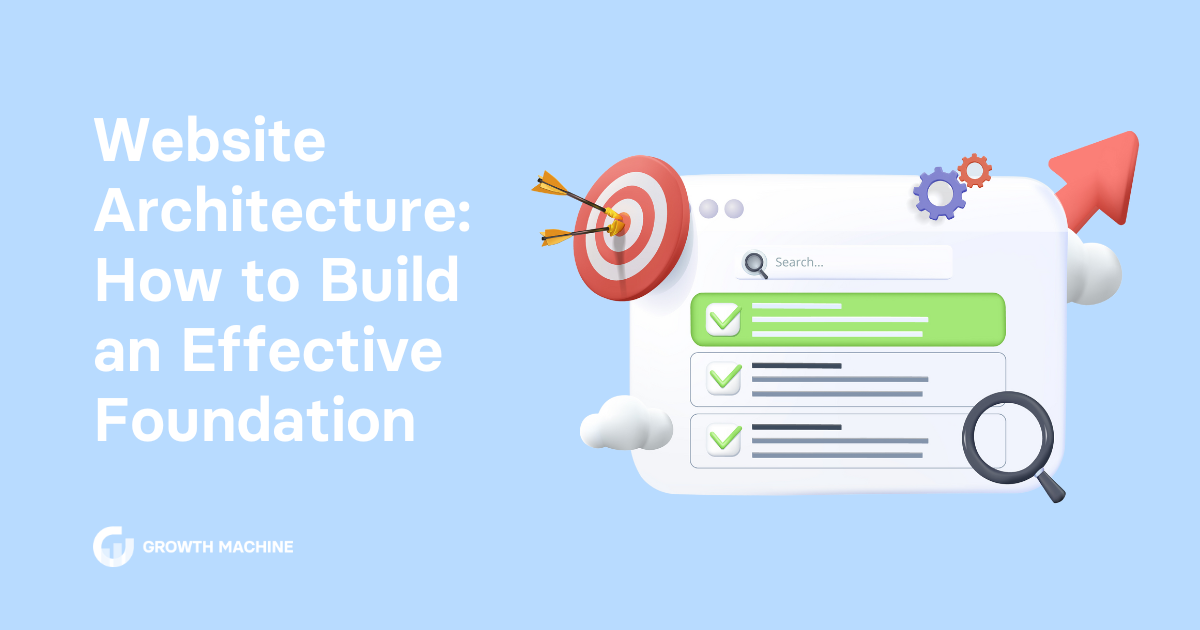Website Architecture: How to Build an Effective Foundation
If someone told you they were going to build a house without any blueprints, what would you tell them? You’d probably warn them against the idea (or at least be glad you’re not the one living in this house).
Effective plans are essential to building anything of value. You need to lay a strong foundation before you can move on to the bells and whistles. The same is true when it comes to websites.
Website architecture is the general blueprint for your entire site domain. As you probably already know, every website is made up of numerous different individual webpages. With website architecture, you plan out how you want all these pages to interconnect so users can efficiently and effectively navigate your site.
But what’s good website architecture? Effective website architecture ensures your new site is user-friendly, functional, and optimized for search engine ranking pages (or SERPs).
You need to walk before you run when it comes to any aspect of digital marketing. Understanding good website architecture right from the start will set you up for success on various different metrics, from driving conversions to building the best possible SEO strategy.
If you’re ready to become something of a website architect yourself, you’ll want to keep these three steps in mind:
- Plan ahead.
- Simplify, simplify, simplify.
- Make the most of linking.
First, let’s clarify why website architecture matters so much in the first place.
Why Does Website Architecture Matter?
Without website architecture, your entire digital presence will fall apart. If you neglect this foundation, even the most aesthetically-pleasing web design in the world won’t keep users on your page for more than a couple of clicks.
That’s because website architecture is the bedrock of digital usability and functionality. Without it, users get confused because you’ve made things too complicated.
And you know what happens then, don’t you? They leave before they can convert on anything of value! This cuts even deeper for SaaS or e-commerce sites as it means fewer sales.
What Does Good Website Architecture Achieve?
Good website architecture helps to ensure that your website is functional and user-friendly. A well-structured website makes it easy for users to find what they’re looking for and navigate your website without frustration. This is a recipe for success when it comes to engagement and conversions.
In addition, effective website architecture can help search engine optimization (SEO) efforts for your company, too. Search engine algorithms like PageRank comb through and index millions of websites.
So, effective website architecture doesn’t just drive conversion — it also directs traffic to your site. You’ll practically be on cruise control when you supplement these blueprints with a stellar user experience and SEO strategy.
Step 1: Plan Ahead
What do you need before laying out the plans for your website? A plan for those plans! Attack even the most rudimentary phase of this brainstorming process with a systematic and step-by-step approach.
Take time to think about the best site architecture for your customers’ needs before you start charting the blueprints themselves. Planning ahead can help ensure your website hierarchy is well-organized and optimized for user experience, SEO, and maximum functionality.
Here are some tips for mapping out the best website architecture strategy possible.
Consider User Needs
Start by considering the needs and wants of your target audience.
Your top business goal should always be to align with your users’ and consumers’ wants and needs. Craft customer personas to figure out how they would intuitively navigate a site like yours.
The goal should be to widen the net and create an accessible user experience for everyone who comes upon your website. After SEO draws new potential customers to your site, you need both intuitive website architecture, as well as beautiful blog design, to keep them there.
Website architecture ensures they can navigate through your site, whereas the blog or site design itself functions a bit more like the interior decoration of a house. The former is primarily about functionality, whereas the latter focuses on aesthetic appeal. Both are essential to keeping users engaged and clicking through your domain.
What are people looking for when they visit your website? What information or products do they need? Answering these questions can help you determine the structure of your website and ensure that it meets the needs of your users.
Build a Sitemap
A sitemap is a visual representation of the pages on your website and how you plan to organize them. Building a sitemap can help you lay out your website’s structure, including the hierarchy of pages and how they all link together.
For example, you could use a hierarchical structure where each individual page falls within a filing system. Think of every site within your domain as Russian nesting dolls. Your landing page is the biggest, the items on your navigation bar are smaller, and each link further down the chain gets even smaller.
Transferring this sitemap into your HTML for the domain can also help search engine crawlers understand the taxonomy of your website. Just as these crawlers will comb through headers on each individual page, they’ll also rely on each rung of your sitemap to decide where to rank you via the algorithms powering them.
Organize to Optimize
Once you have a sitemap, it’s time to organize your website’s content. This process includes creating category pages and subcategories, and developing a template for your site. Your goal here is to determine how each individual page will link to another.
This step is critical to ensure your website is well-organized and easy to navigate. A well-organized site is a well-optimized site. The easier it is for algorithms to process your data, the more likely you’ll show up high on SERPs for users. You’ll be set up for ultimate success when you pair this with additional strategies to boost your website ranking.
Step 2: Simplify, Simplify, Simplify
A good site structure should be easy to navigate from the main page onward. It should avoid confusing users with too many options or too much information. Endless site links to infinite website pages will only confuse your customers.
Simplicity is the most important ingredient when it comes to website architecture. It not only helps users navigate the site but also assists search engines in indexing pages for better search engine optimization (SEO).
Here are a few tips for simplifying your website structure.
Make Navigation Easy
One of the most crucial steps in creating a good website structure is to ensure navigation is as easy as possible. For example, the main site navigation menu should be easy to find, use, and understand. It should also reflect the overall structure of your website, so users can quickly and intuitively find what they’re looking for on different pages.
No matter where a user is on your site, they should never have trouble navigating back to where they were before or finding the next place they want to be. This means keeping your main links visible at all times and including a search bar for everything else.
Avoid Orphan Pages
Orphan pages make it difficult for users to navigate your website — something you need to avoid whenever possible.
They don’t link to anything anywhere else on your site. They often don’t have anything linking to them either. You may think that sounds unnecessary — and you’d be right! Still, so many companies can get caught up in creating content that they forget to eliminate new pages like these.
Orphan pages can also lead to unnecessary keyword cannibalization, where multiple pages on your site compete for the same keyword, reducing their efficacy when it comes to SEO. While you should strive to prevent this from happening in general, it’s even more unnecessary and counterproductive when the piece of content is a silo unto itself.
Opt for Flat Architecture
Flat architecture (in contrast to deep architecture) is a straightforward way to simplify your website structure.
In this approach, you organize your website with the smallest number of categories, making navigating easier for users. That way, from the homepage to the newest blog post, users can always easily navigate the main categories and subcategories of your website.
A good practice for flat architecture is card sorting, which helps organize your content into categories based on the user’s perspective. A homepage that provides access to all relevant pages can help achieve this goal. The internal linking structure throughout the site should reflect this as well.
Step 3: Make the Most of Linking
Interlinking is another crucial element of website architecture.
From the most important pages downward, effective on-page linking is how you start turning the blueprints for your website into the full-blown building your customers deserve. It’s also one of the main ways this design process intersects with SEO strategy. When you get the skeleton of your site right, linkbuilding tools become much more effective.
These are just a few key pieces of advice to keep in mind as you start your linking strategy.
Aim for the Least Amount of Clicks
When designing your website’s architecture, aim to minimize the clicks required to get to the most important pages. For example, on e-commerce websites, this means making sure that product category pages are easy to find and that individual product pages are no more than a few clicks away.
Take Amazon as an example. They’ve become the most successful e-commerce site in the world, partially because purchasing just about any product is possible with a single click. No matter what type of website you have, utilize this information. Every page on your own site should be accessible with three or four internal links (or clicks) at maximum.
Use the Pillar/Cluster Approach
The content pillar/topic cluster approach is another way to optimize your website’s information architecture.
In this method, you organize your website’s pages around subtopics related to the main topic. For example, if you have a website focusing on cooking, you might have subtopics related to baking, grilling, and meal planning.
Organizing each webpage in this manner helps search engines understand the structure of your website and improves your chances of ranking for relevant keywords. This approach to designing website content will also help you supercharge your SEO in general, especially when paired with thorough keyword research.
Incorporate “Breadcrumbs”
Breadcrumbs are another valuable tool for improving your site structure.
They provide a link trail showing users the path taken to get to the current page above the headings of each individual page. It’s an intuitive addition to website design, and you’ll see breadcrumbs on many user interfaces.
This helps users navigate the site and provides context for search engines. Breadcrumbs should be incorporated into your website’s design and placed in a prominent location, such as the top of the page.
Now That You’ve Built Your Website, How Do You Get It Noticed?
Your website structure will help you drive conversions, increase traffic, and maximize functionality for users. Getting these blueprints right is also essential for your content marketing strategy as a whole.
Still, great website architecture is just the baseline. You’ll need a lot more to take your site to the heights you deserve. From creating your content strategy framework to helping with keyword research, we can supercharge your site for SEO success.
Contact us if you’re ready to pair terrific website architecture with powerful search engine optimization (SEO). After you build the foundation, we can help you create content that’ll keep customers clicking and converting.







